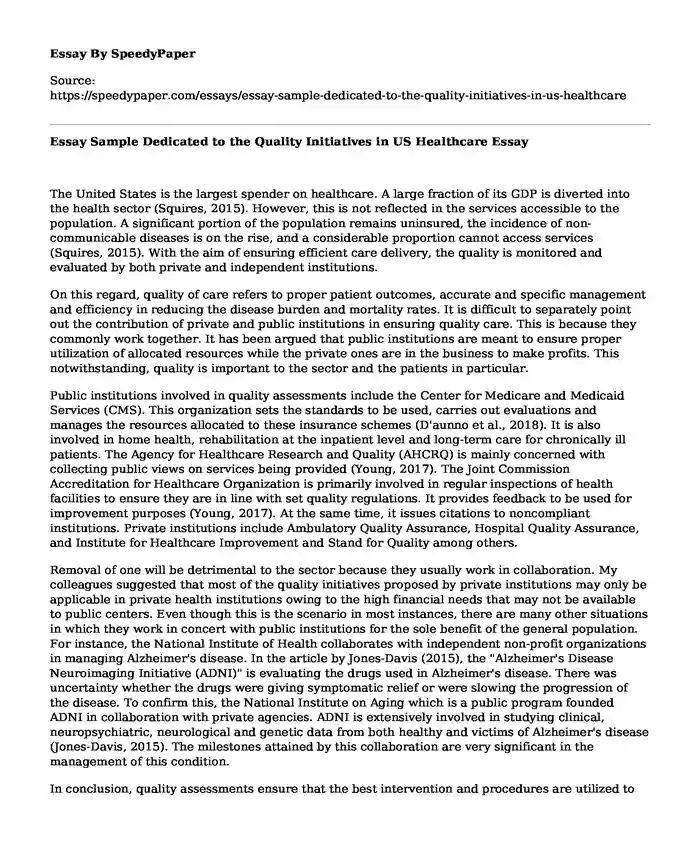
| Type of paper: | Course work |
| Categories: | Healthcare policy |
| Pages: | 3 |
| Wordcount: | 644 words |
The United States is the largest spender on healthcare. A large fraction of its GDP is diverted into the health sector (Squires, 2015). However, this is not reflected in the services accessible to the population. A significant portion of the population remains uninsured, the incidence of non-communicable diseases is on the rise, and a considerable proportion cannot access services (Squires, 2015). With the aim of ensuring efficient care delivery, the quality is monitored and evaluated by both private and independent institutions.
On this regard, quality of care refers to proper patient outcomes, accurate and specific management and efficiency in reducing the disease burden and mortality rates. It is difficult to separately point out the contribution of private and public institutions in ensuring quality care. This is because they commonly work together. It has been argued that public institutions are meant to ensure proper utilization of allocated resources while the private ones are in the business to make profits. This notwithstanding, quality is important to the sector and the patients in particular.
Public institutions involved in quality assessments include the Center for Medicare and Medicaid Services (CMS). This organization sets the standards to be used, carries out evaluations and manages the resources allocated to these insurance schemes (D'aunno et al., 2018). It is also involved in home health, rehabilitation at the inpatient level and long-term care for chronically ill patients. The Agency for Healthcare Research and Quality (AHCRQ) is mainly concerned with collecting public views on services being provided (Young, 2017). The Joint Commission Accreditation for Healthcare Organization is primarily involved in regular inspections of health facilities to ensure they are in line with set quality regulations. It provides feedback to be used for improvement purposes (Young, 2017). At the same time, it issues citations to noncompliant institutions. Private institutions include Ambulatory Quality Assurance, Hospital Quality Assurance, and Institute for Healthcare Improvement and Stand for Quality among others.
Removal of one will be detrimental to the sector because they usually work in collaboration. My colleagues suggested that most of the quality initiatives proposed by private institutions may only be applicable in private health institutions owing to the high financial needs that may not be available to public centers. Even though this is the scenario in most instances, there are many other situations in which they work in concert with public institutions for the sole benefit of the general population. For instance, the National Institute of Health collaborates with independent non-profit organizations in managing Alzheimer's disease. In the article by Jones-Davis (2015), the "Alzheimer's Disease Neuroimaging Initiative (ADNI)" is evaluating the drugs used in Alzheimer's disease. There was uncertainty whether the drugs were giving symptomatic relief or were slowing the progression of the disease. To confirm this, the National Institute on Aging which is a public program founded ADNI in collaboration with private agencies. ADNI is extensively involved in studying clinical, neuropsychiatric, neurological and genetic data from both healthy and victims of Alzheimer's disease (Jones-Davis, 2015). The milestones attained by this collaboration are very significant in the management of this condition.
In conclusion, quality assessments ensure that the best intervention and procedures are utilized to provide proper patient care. As such, quality initiatives are meant for the patient's benefit.
References
D'aunno, T., Broffman, L., Sparer, M., & Kumar, S.R. (2018). Factors That Distinguish High-Performing Accountable Care Organizations in the Medicare Shared Savings Program. Health services research, 53(1), 120-137.
Jones-Davis, D.M., & Buckholtz, N. (2015). The impact of the Alzheimer's Disease Neuroimaging Initiative 2: What role do public-private partnerships have in pushing the boundaries of clinical and basic science research on Alzheimer's disease? Alzheimer & dementia: the journal of the Alzheimer's Association, 11(7), 860-864
Squires, D., & Anderson, C. (2015). US health care from a global perspective: spending, use of services, prices, and health in 13 countries. The Commonwealth Fund, 15, 1-16.
Young, K.M., & Kroth, P.J. (2017). Sultz & Young's Health Care USA. Jones & Bartlett Learning.
Cite this page
Essay Sample Dedicated to the Quality Initiatives in US Healthcare. (2022, Apr 01). Retrieved from https://speedypaper.net/essays/essay-sample-dedicated-to-the-quality-initiatives-in-us-healthcare
Request Removal
If you are the original author of this essay and no longer wish to have it published on the SpeedyPaper website, please click below to request its removal:
- Save The Bay Movement - Free Essay on Environmental Protection
- Character Analysis Essay: Hamlet Is a Man of Action
- Free Essay on Socrates' Philosophies and Business Management
- Gender and Language Essay Example
- Essay Example on Effective Billing and Management of Revenues
- Aristotle's Kefutation of Parmenides. Paper Example
- Free Essay. Applied Behavioral Analysis in Public Schools
Popular categories




